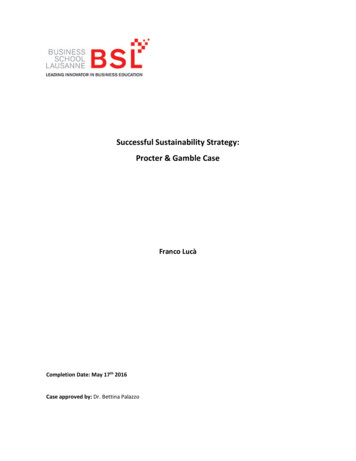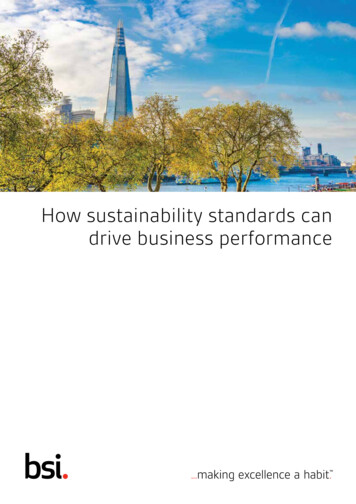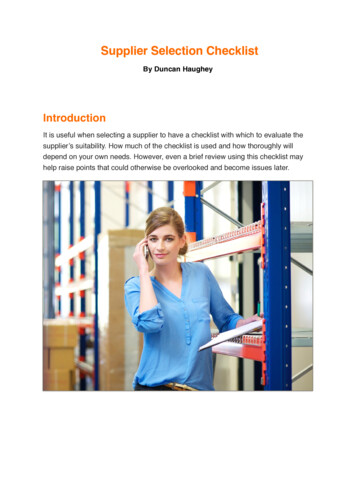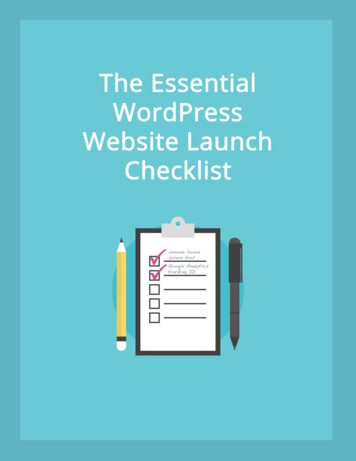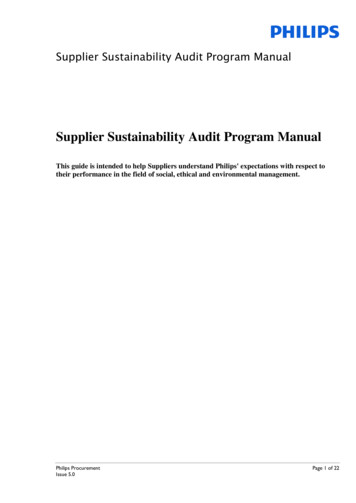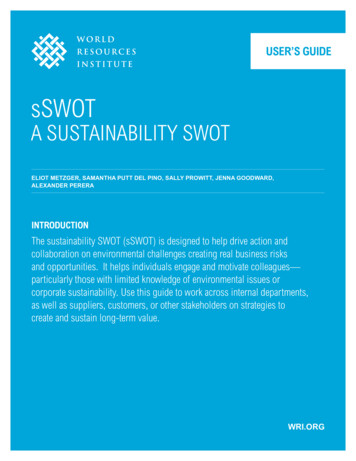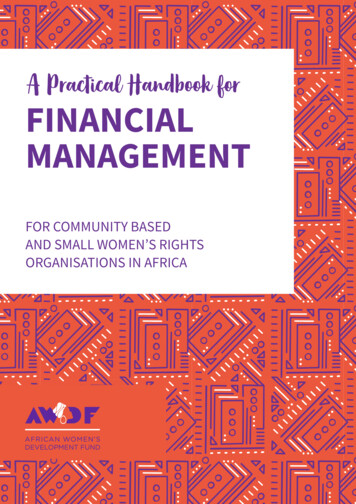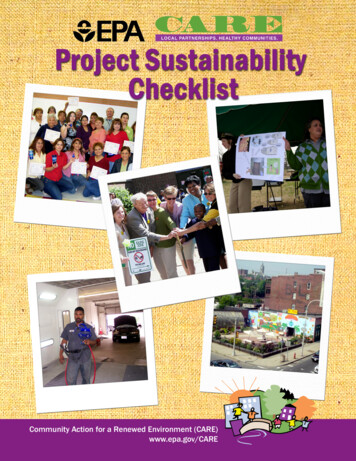
Transcription
Project Sustainability ChecklistSustainable CARE projects arecommunity-based partnerships thatcontinue to improve the localenvironment after CARE funding ends.www.epa.gov/CARE
Purpose of the ChecklistThis checklist is a tool developed to help CARE communities focus your CAREprogram activities in a manner that will help you work toward long-term projectsustainability. It will help you think through some of the elements that havehelped other CARE communities sustain their work. It is not a roadmap or acookbook, but it is a method to ensure that you can reach the goal of projectsustainability. The application of each element described in the checklist willvary from community to community depending on the circumstances. Use thischecklist as: a planning tool throughout your project;appropriate and adapt it to help you plan for sustaining your work; andthe basis for discussions in your partnership to help identify areas thatneed additional attention.Remember, you have the best chance for success if you plan with sustainabilityin mind from the beginning of your project.Checklist SectionsI.II.III.IV.V.Developing the Foundation for Success—page 5Building and Sustaining the Partnership—page 7Developing the Project Workplan—page 10Conducting the Work, Celebrating Success and Learning from the Process—page 11Obtaining Sustainable Resources—page 12Appendix A—page 15Potential Ways for EPA to Help Communities Achieve Long-term Project SustainabilityAppendix B—page 16Example Logic ModelCARE Program OverviewThe U.S. Environmental Protection Agency’s (EPA) Community Action for aRenewed Environment (CARE) program is a competitive grant program thatoffers communities an innovative way to address the risks from multiple sourcesof pollution in their environment. The program is designed to help communitiesbuild the capacity they need to continue their work long after the CARE fundinghas ended and continue to achieve results long after EPA grant funds areexhausted. This is the fundamental concept of project sustainability.www.epa.gov/care2
Some additional information has been collected on how EPA might helpcommunities work toward project sustainability. Those ideas are included inAppendix A.CARE grantees follow a four-step process to successfully complete their CAREproject. Grantees:1. Bring together all stakeholders to form a broad-based partnershipdedicated to reducing toxics in the local environment. Partners mayinclude: Non-profit groups, Community organizations, Businesses, Schools, State, Tribal and local government agencies, EPA and other federal agencies.2. Identify problems and solutions. Working together, the partnershipassesses the risks from toxics in the community and considers options forreducing those risks. EPA provides technical assistance as needed tosupport this process.3. Implement solutions and reduce risks. The partnership identifies andimplements the combination of programs that best meet the community'sneeds with EPA providing funding to help with implementation. Thecommunity begins improving its environment, while continually reassesingrisks and priorities.www.epa.gov/care3
4. Facilitate self-sustaining projects. The community develops new waysto attract funding and partners into its broad-based collaborative to buildon its success. New problem assessments are completed and newsolutions identified. As a result, the project becomes self-sustaining andcontinues to improve the environment where community members live,work and play.As communities identify problems and solutions, the CARE admap.pdf) can be used to helpguide the process. Similarly, this checklist provides guidance to communities asthey work toward long-term project sustainability. We all know that it is unrealisticto think that the environmental concerns facing communities will be completelysolved in the two or four years of CARE funding. CARE communities should usethe opportunity presented by the CARE funding to plan carefully for sustainingtheir work over the long-term.Sustainable CARE projects are community-basedpartnerships that continue to improve the localenvironment after CARE funding ends.www.epa.gov/care4
Key Elements of Sustainable CARE ProjectsThe Checklist has five sections, each covering a number of key elements.Examples and descriptions are included to help you think about the individualelements and how they may apply to your project. Check whether yourorganization has addressed each element or whether your organization mayneed further work in that area.I. Developing the Foundation for Successa. Develop a mission or vision statement for the organization or project.The mission or vision statement is the longterm objective for the organization orExample of Mission andproject.Vision Statementsb. Develop a set of guiding principles thatis agreed upon by all members of thepartnership. A set of guiding principleshelps ensure that all members of thecollaboration are working in a similarmanner with similar priorities.c. Develop project goals that arecommunity inspired and communitydriven. Goals should be bold and excitingand must be clear, simple and compelling.These are the individual achievementsneeded to reach the organization orproject’s mission.1. Engage community members in thedevelopment of goals. Goals mustcome from the people. They must haveownership of the goals and see thegoals as crucial to their lives.South Atlanta for theEnvironment (SAFE) CoalitionSAFE Coalition used the CARESustainability Checklist in theplanning process and came upwith the following vision andmission statements.Vision: A community free ofenvironmental hazards, whichpromotes health and safety forall.Mission: To work together as ateam to identify, publicize,reduce and preventenvironmental health hazards inSouth Atlanta neighborhoodplanning.2. Ensure that the goals fit with overall community priorities. Figure outhow the goals of your project support and help the community reach itsother priorities. You may wish to include your work as part of a totalcommunity revitalization plan ensuring that it fits with the other communitypriorities.www.epa.gov/care5
Example of Guiding Principles and Community Inspired,Community Driven GoalsWest Oakland - Using a Partnering AgreementWest Oakland is immediately adjacent to the Port of Oakland, one of the largestcontainer ports in the U.S. After concluding a small scale study of diesel trucks with13 action oriented recommendations, the West Oakland Environmental IndicatorsProject (EIP) chose to use the study results to bring together a broad set ofstakeholders to address in a collaborative fashion the broader set of toxics issuesfacing the community. To structure the collaborative, the EIP partnered with EPARegion 9 and adapted a partnering agreement previously developed for use inBarrio Logan in San Diego. The agreement includes a formal definition of theCollaborative and its goals, as well as the roles of the co-leads (EIP and EPA),Steering Committee and member partners. The agreement provides forcommunity co-chairs and neutral facilitation. The West Oakland Toxic ReductionCollaborative (WOTRC) was formally launched in March of 2005.The Partnering Agreement addressed the needs and opportunities to (1) formallyand structurally empower the community and (2) address a broad set of toxicissues in a multi-stakeholder format. The formal Partnering Agreement providedfor a neutrally facilitated multistakeholder collaborative. Key outcomes were: Community co-chairing is essential. “Community” in this sense refers torepresentatives of the impacted community. The community co-chaired theCollaborative at every level, including every workgroup, the SteeringCommittee and the full Collaborative. Neutral facilitation was essential. Further, there was a clear lesson thateffective facilitation should not only be neutral, but knowledgeable andexperienced regarding the issues on the table and the players at the table. Effective collaboration is not as simple as bringing key stakeholders togetheraround a table, but requires orchestration to ensure that all the key sectorsare effectively represented and heard. Effective involvement by the impacted community requires special attentiondue to a comparative lack of resources and capacity in comparison to othersectors such as industry and agencies, especially on technical and legalissues.www.epa.gov/care6
d. Define what long-term sustainable success means for your project andorganization. One of the key goals of the CARE Program is for each CAREcommunity to develop the capacity to continue to work over the long-term toimprove its environment and environmental health.1. Discuss and define what long-term sustainable success is for yourproject.2. Clarify and decide up front with the collaboration what long-termsustainability means. Does it mean to merely finish the specific project that was started? Will it mean continuing the work and the collaboration after the grantends? Will the collaboration create a new group or organization that willcontinue the work or seek to institutionalize a new function in anexisting organization to continue the work?II. Building and Sustaining the Partnershipa. Develop a long-term plan for continuing your work after the CAREfunding ends. The key to continued success is having a shared communityvision that will drive the process for the long-term.You may need to develop a long-term plan, not just for the two or four yearsof the CARE grant. It may take much longer to make the significantimprovements you envision.Plan to work consistently for at least the length of time of the one or twoCARE grants; avoid stopping and starting work, as this can be very disruptiveto community members and can drain their energy.b. Develop short-term gains or milestones that are steps in your long-termplan. A long-term plan may seem overwhelming for some members of yourcollaboration. Short-term gains or milestones break the project into doablesteps. Attempt to progress through your short-term plan at every meeting.Acknowledge and/or celebrate even the smallest successes or victories.c. Enlist and develop leaders from all sectors of your partnership. Projectsneed collaborative leaders interested in promoting leadership skills ineveryone.www.epa.gov/care7
1. Create and implement a plan for leadership development. Ensuringstrong leadership for the long-term will require planning for leadershipdevelopment from the start.2. Recognize and value diversity (e.g., age, ethnic, economic, social) inyour leadership team.3. Plan for succession so that the organization/partnership is notdependent on a single individual or leader.4. Make sure that the organization has a succession plan formanagement.d. Develop a plan for engaging organizations and community members.To succeed you will need both a partnership with the key stakeholders anddeep community involvement.1. Seek organizations that help you reach and engage communitymembers, such as churches, clubs, business associations, PTAs,neighborhood associations or local government representatives. Byreaching out to diverse and already established and supported communityorganizations, you will help ensure that many members of the communitywill be represented. In determining your plan for reaching out, consider,"Who is currently not represented from this community?"2. As needed, bring government agencies, universities, nonprofits,business groups, and other stakeholders into your partnership.Engaging each sector of your partnership may require a separateapproach. Some stakeholders may have had adversarial relationships inthe past and will need special attention and planning.Know that there are EPA resources currently available to address some ofthe social issues that many communities face.3. Ensure that the impacted community is fully represented. Theirinsights and participation will be crucial to the partnership’s success.Remember, that unless you are a member of the impacted community,you may need to spend a significant amount of time building trust.4. Engage the youth and elders of the community. Their participation hasproven to be a key driver for many successful projects. How will you getyouth and elders involved in the work?www.epa.gov/care8
5. Seek partners who have special skills that can enhance the project.For example community college professors who can help analyze data, orunderstand survey research techniques. People or organizations withmeeting facilitation skills can also be extremely valuable.e. Develop a governance structure for yourproject that helps build a strongpartnership and organization. You willneed a strong governance structure tocoordinate and lead the work of yourpartnership for the long-term. Your structureshould reflect your mission statement andguiding principles.1. Develop policies and proceduresagreed upon by all members of thepartnership. Establish policies andprocedures to ensure smooth operation ofthe decision-making process thatencourages participation and builds trust.Example of Policies andProceduresConsider developing policies andprocedures such as: Establishing open proceduresfor filling leadership positions,setting agendas, and makingdecisions; Setting meeting times carefullyand providing support wherenecessary to accommodatemembers, especiallycommunity members; Modeling respect anddemonstrating a clear desire tobe as inclusive as possible; Ensuring enough time foreducation and the exchange ofideas to create a level playingfield among members, and; Using a consensus model fordecision-making.2. Engage Stakeholders. Members of yourpartnership will become involved, committheir resources, and remain for the longterm if: They think that the organization isdoing important work; They are respected by others; They trust the organizations orindividuals involved in the project; They feel they are making a significantcontribution to the work; The work is shared equally; Decisions are made in a fair manner; Throughout the project they see progress; and The time spent together is generally fun and fulfilling.3. Avoid creating a governance structure that makes decisions in avacuum, creates barriers to involvement, or does work separate fromthe broader community. Regularly reassess your structure to look forunintended consequences. Build an organization that sees itself as thefacilitator for community decisions and community action, helping towww.epa.gov/care9
ensure community ownership of and community resources for the workthat needs to be done.III. Developing the Project Workplana. Develop a workplan based on the short and long-term goals of theproject. Using your goals as a guide, develop a workplan consisting ofindividual activities. Assign leads for each activity and time frames foraccomplishing them.Consider using a "Logic Model" to document your plan and your progress. Anexample logic model is included in Appendix B.b. Lay out strategies for accomplishing the activities in your workplan.Each activity might require separate tasks. Determine what resources areneeded to accomplish the tasks. An organizational structure may need to bedeveloped to track the tasks as they are completed.c. Establish measures of success for your work. What will success looklike? How will you know you are achieving it? These are questions that arecritical to project planning and management. The use of measurementenables you to demonstrate to yourself and outside parties that you havethoughtfully considered what work needs to be accomplished to evokepositive environmental change, and that you are accomplishing your goalsand documenting your progress.1. Choose behavioral measures touching on each key work area (e.g.,building and maintaining a strong collaborative, achievingenvironmental and public health benefits, developing communitycapabilities) and use them to inform your partnership. What couldyou do to move further towards empowering your community to take onthese issues? During your grant project, what targets can be set that willkeep the partnership focused on meeting its goals? What key behaviorsdo you aim to influence and change? Write these behaviors down anddetermine ways to measure these actions, monitor them throughout yourgrant, and report your successes.2. Focus on a few strong environmental measures and back them upwith a solid calculation methodology.www.epa.gov/care10
Example of Measurable Goals and OutputsSonora Environmental Research Institute, Inc. (SERI)SERI set the following goals to measure the success of its program CommunityAssist of Southern Arizona (CASA).Goal 1: Implementation of a voluntary pollution prevention program for all industrysectors of concern with a goal of 50% participation where participation is defined assuccessful referral to business assistance organization, attendance at a pollutionprevention workshop, and/or implementation of best environmental managementpractices.Goal 2: Participation of 75% of the families found to have lead containing items intheir homes in a voluntary childhood lead poisoning prevention strategy.Goal 3: Development of a draft zoning ordinance based on the environmentalzoning concepts.Goal 4: Participation of 25% of the families receiving home visits in other CASAactivities.Goal 5: Retention of promotoras in the program during the grant period with a goalof 95%.d. Prepare an evaluation plan. You must have a program evaluation processwith methods to measure the effectiveness of the program, as well as be ableto make any necessary changes. This is key to sustaining a long-term project.Participants need to have a clear and open way to develop lessons learned,correct mistakes and celebrate breakthroughs. Without this, the effort willeventually break down.IV. Conducting the Work, Celebrating Success and Learningfrom the Processa. Conduct activities as laid out in your workplan. Conduct your activitiesaccording to the workplan, while remaining flexible to opportunities that arise.b. Set a tone that makes it fun to be part of the organization and project.Make the organization and project fun and exciting to be a part of by includingfood, learning opportunities, retreats, celebrations and awards.www.epa.gov/care11
c. Evaluate progress and revise activities as needed. Evaluation, followedby revision or adjustment, is a critical component of sustainability. As acollaborative, regularly evaluate your progress so that you learn from yoursuccesses and failures and grow as a group.d. Celebrate success and acknowledge steady progress that is real andtangible, so that people are encouraged to continue the long-term effort.Clear progress and even small successes will be a key to enthusiasm. Ensurethat success is celebrated. Plan for accomplishing something at least everysix months. Put up a chart and mark off progress visually at each meetingand/or develop another method to track the group's success.e. Regularly report progress to funders and to the community. You will beasked to report to funders on a regular basis about the progress you aremaking. Make this a reflective and valuable time to assess your work andprocesses. Report out your findings to the group and readjust the plan, ifnecessary.V. Obtaining Sustainable Resourcesa. Determine your core funding and resource needs and develop a plan forhow to obtain them. Most projects will need some funding or otherresources to continue long-term work. Take the time before your CAREfunding ends to work together to identify your core funding and resourceneeds and develop a plan for obtaining these funds. Will you need funding forinsurance, office space, printing? Funding and support for the staff andcommunity leaders who do the work to organize and facilitate the partnershipwill be especially important for sustaining your work. Can you get your partnerorganizations to commit to sharing this responsibility? How will you findfunding to support community leaders to do this work?b. Carefully consider where to use your grant funds and your partnershipresources to make your work both successful and sustainable. You willneed to make tough choices as you find the best balance between using yourresources, including your grant funds, to get immediate results and using yourresources to ensure the continuation of your work for the long-term. Aspectsof your work, such as training and development; strengthening therelationships in your partnership; broadening community engagement; andadvertising your successes, will help to ensure the sustainability of your work.How much of your time and resources can you devote to building your longterm sustainability?www.epa.gov/care12
c. Explore a full range of funding and resource options, diversify yourincome, and reduce reliance on a single revenue source. Look for otherfunding sources besides government grants, such as private foundations andlocal community organizations. When possible, utilize in-kind and donatedservices. Plan to continue to mobilize volunteers for community projects. Askyour partnership to help with this responsibility.Example of Approach to Sustainable FundingWE ACT for Environmental Justice’s Approach to Sustainable FundingSince 1988, WE ACT for Environmental Justice has consistently raised funds to support variousmulti-year projects in environmental health, sustainable development, movement building, andgovernment/corporate accountability. Our annual budget currently stands at 1.6 million,represents a combination of public and private dollars, and is a reflection of our philosophy thatany non-profit organization must implement Sustainable Funding practices to survive. WE ACT’sapproach to Sustainable Funding is built on 3 pillars:1) Diversification of Funding SourcesAs part of our diversification strategy, WE ACT pursues a wide array of government(state and federal) and foundation support throughout each year. We also holdfundraising events through which individual donors and gifts are cultivated.2)Leveraging Existing DollarsWhen pursuing government and foundation grants, we make it a point to leverageexisting dollars by designing new projects that build on the foundations of previouslysuccessful initiatives. Thus, none of our work is unnecessarily repetitive, and fundingfrom one supporter is used to set the stage for the work that is carried out under a newsupporter. For example, our current NYC Lead Outreach Campaign was designed tobuild on resources and relationships nurtured through the Our Housing is our HealthCampaign (OHOH), and utilize trainings that were piloted under OHOH. Our currentCARE grant was designed to leverage resources and relationships developed throughour previous environmental health projects.3) Obtaining In-Kind Support from Partner Organizations.Retaining in-kind support is important to remain sustainable. Our in-kind support ismostly in the form of meeting space donated to host meetings or shared collaborationwith other organizations with expertise and capacity not housed within the organization.WE ACT is able to add value to our projects and significantly ramp up the impact of eachindividual initiative through in-kind assistance. This is done without adding money for aconsultant or technical expert to the organizational or project budget.Together, these 3 practices have enabled WE ACT to sustain and grow our funding over the past20 years.www.epa.gov/care13
For more information go to: http://www.epa.gov/care/The Sustainability Checklist was developed by: Mike Bandrowski, EPA Region 9Ogonnaya Dotson-Newman, We ACT for Environmental Justice, Inc.Michelle Mandolia, EPAAbayomi Noibi, Executive Director, ECO-ActionHank Topper, Former CARE Lead for EPAAnn Marie Wolf, Sonora Environmental Research Institute, Inc.Special thanks to Remmington Jackson for her production efforts.If you would like to provide comments or suggestions for revision, please sendthem to Mike Bandrowski at: bandrowski.mike@epa.govwww.epa.gov/care14
Appendix APotential Ways for EPA to Help Communities Achieve Long-termProject SustainabilityIn developing the Sustainability Checklist, some ideas were provided onmeasures that EPA might take to help CARE communities in working towardsustainable projects. While the Checklist focuses on what communities can do towork toward sustainable projects, we wanted to capture the ideas of what EPAcan do to help communities. Below are some examples of ideas. If you haveothers, please provide them to Mike Bandrowski at bandrowski.mike@epa.govPotential Ideas for EPA to Help Provide Project Sustainability1. CARE Academy- Look at providing funding to CARE projects that havesuccessfully completed Level 2 to remain as subject experts to provide expertiseto new CARE communities and to the CARE program as a whole. Fundingwould allow successful CARE communities to attend the national meeting and tovisit with new CARE projects to help them benefit from their expertise andexperience.2. Certificate of Support- As CARE projects apply for further funding withorganizations, it would be helpful for them to be able to provide a letter of supportfrom EPA that states they have successfully completed the CARE Level 2program. Since EPA may not be able to provide individual letters of support, itmight be helpful to provide successful Level 2 projects with a certificate of projectcompletion and support that could be used to show their participation in theCARE program to help them get further funding.www.epa.gov/care15
Appendix BExample Logic Model: West Oakland Toxic Reduction Collaborative (WOTRC)—Phase 3This logic model is an abridged version of one that WOTRC created to plan for the third phase of their work.Where WOTRC is now andSHORT TERM OUTCOMEwhat we see WOTRC’s work beingActivities2a) WHO has2b)2c) HOW(only thingsthe power toWHATINTERMEDIATE OUTCOMESResources/Outputs/that WOTRCbring aboutwe want [weInputsdoes, not thatProductsthe outcome[them]influencethem]Port or targets[that we needto dodo)to influence]WOTRC multipleWOTRCGrants andA. AIR QUALITYstakeholdercapacityfunding,Those responsible for air planningparticipants and whatbuilding toMOU’s fordevelop and implement local airthey bring to the tablesuccessfullyjoint work,plan(s) that reduce communityin expertise,implementin-kindhealth risk from (growing goodsexperience,focus areas 1 membermovement)relationships andand 2contributionsresources such asof staff timeImproved community andstaff time and funding: Conveningand othergovernment/ agency collaborationresources Meaningful community Community based forums forcollaborativeengagement in the processorganizationsSee the table belowproblemMeeting Transparent disclosure of Elected officialssolvingproceedings,government/ agency Governmentplansofoperations to impacted IndustryOutreachtoaction,communities Intermediarieseducate,learning/technical expertsengage, andB. LAND USE LabormaintainDocumentThose responsible for land usemomentumationplanning develop and implementFundinglocal land use plan(s) that moveAssessment,polluting trucks and truck servingIn-kind contributionsanalysisandbusinesses out of the West(e.g., staff time,monitoringOakland residential neighborhoodmeeting space)and onto appropriate industriallands (i.e., base reuse)Non-WOTRC activitiesthat can be leveragedLONG-TERMOUTCOMESReduced toxic airemissions and dieselpollution fromstationary andmobile sourcesReducedincompatible landuses to promotesafe, healthy, andsustainablecommunityReduced proximityand impact of dieseltruck traffic to WestOakland residentsReduced publicexposure to airtoxics/improvedpublic healthC. CAPACITY BUILDING16
WHAT (2b)A. AIR QUALITY1TRUCK ROUTES23Make sure that truck routes are implemented,monitored, enforcedTRUCKER OUTREACH AND EDUCATIONShort Term Outcomes*WHO (2a)The city (e.g., the planningdepartment)HOW(2c)Public pressureHave them report to WOTRCProvide education and outreach to truckersThe county (interstate)The city/unions/otherindustry associations/dispatchersPertains to truck routes and clean up plansALTERNATIVE FUELSProgressive truckersCreate opportunities (e.g., green lanes)Use alternative fuels and alternative fuel vehiclesTerminal operatorsApply pressure and generate will (e.g., better enforcement,political support, champions, grants and other funding, mayoralsupport)Fuel suppliersPeriodic reporting back from the cityElected officials4BLUEPRINT (Move it forward)State/countyJPC/ABAG5&6bHEALTH STUDIESFederal elected officials- Help West Oakland obtain funding to do health studies- Really recognize disparate impacts- Collaborate with other officials- Bring site health data and other information intoregion/local health database/repositoryAIR PLANAlameda County PublicHealth Department6a“70 block program” WOTRC (HIP, Breathe CA track air plandevelopment and implementation against commitments andcommunity goals (assess at the front end, track againstestablished metrics during implementation)Briefings, testimony, reports (Identify specific existing reports),letters from agencies/academics around top priorities(research/action)Tell elected officials the top priorities of the communityAlameda County PublicHealth DepartmentThrough WOTRCThrough WOTRC- Create a local air quality plan focused on reducing allhealth risks- Create an enforcement “task force” (county, CARB,BAAQMD, city planning, EPA, city attorney department)- includes truck clean-up plan17
Noteswww.epa.gov/careJune 2010EPA ‐530‐F‐10‐00218
Facilitate self-sustaining projects. The community develops new w to attract funding and partners into its broad-based collaborative to build on its success. New problem assessments are completed and new solutions identifie ays d. As a result, the project becomes self-sustaining and continues


